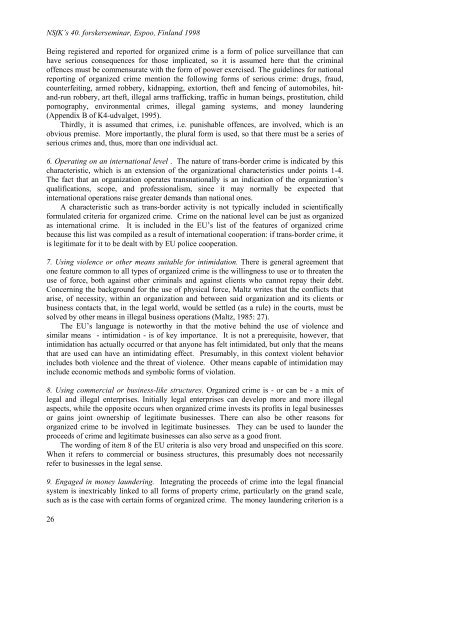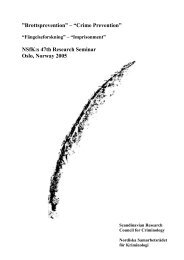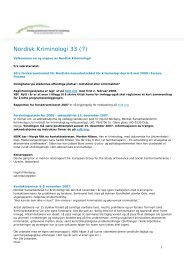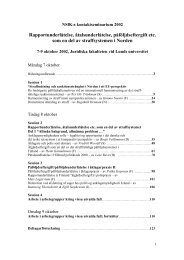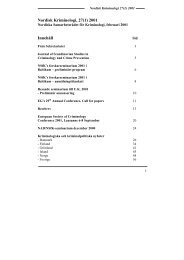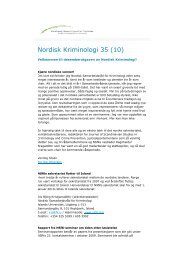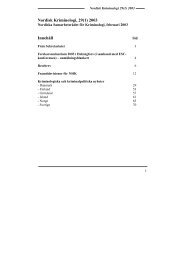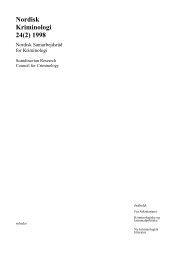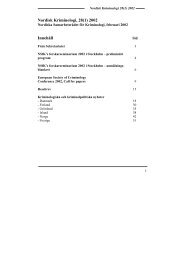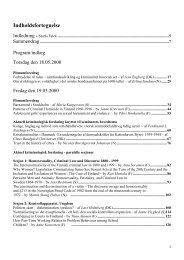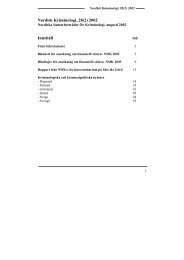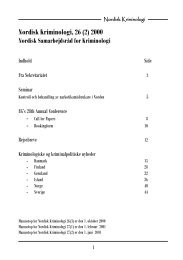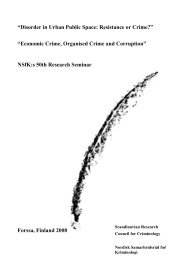Organised Crime & Crime Prevention - what works? - Scandinavian ...
Organised Crime & Crime Prevention - what works? - Scandinavian ...
Organised Crime & Crime Prevention - what works? - Scandinavian ...
You also want an ePaper? Increase the reach of your titles
YUMPU automatically turns print PDFs into web optimized ePapers that Google loves.
NSfK’s 40. forskerseminar, Espoo, Finland 1998<br />
Being registered and reported for organized crime is a form of police surveillance that can<br />
have serious consequences for those implicated, so it is assumed here that the criminal<br />
offences must be commensurate with the form of power exercised. The guidelines for national<br />
reporting of organized crime mention the following forms of serious crime: drugs, fraud,<br />
counterfeiting, armed robbery, kidnapping, extortion, theft and fencing of automobiles, hitand-run<br />
robbery, art theft, illegal arms trafficking, traffic in human beings, prostitution, child<br />
pornography, environmental crimes, illegal gaming systems, and money laundering<br />
(Appendix B of K4-udvalget, 1995).<br />
Thirdly, it is assumed that crimes, i.e. punishable offences, are involved, which is an<br />
obvious premise. More importantly, the plural form is used, so that there must be a series of<br />
serious crimes and, thus, more than one individual act.<br />
6. Operating on an international level . The nature of trans-border crime is indicated by this<br />
characteristic, which is an extension of the organizational characteristics under points 1-4.<br />
The fact that an organization operates transnationally is an indication of the organization’s<br />
qualifications, scope, and professionalism, since it may normally be expected that<br />
international operations raise greater demands than national ones.<br />
A characteristic such as trans-border activity is not typically included in scientifically<br />
formulated criteria for organized crime. <strong>Crime</strong> on the national level can be just as organized<br />
as international crime. It is included in the EU’s list of the features of organized crime<br />
because this list was compiled as a result of international cooperation: if trans-border crime, it<br />
is legitimate for it to be dealt with by EU police cooperation.<br />
7. Using violence or other means suitable for intimidation. There is general agreement that<br />
one feature common to all types of organized crime is the willingness to use or to threaten the<br />
use of force, both against other criminals and against clients who cannot repay their debt.<br />
Concerning the background for the use of physical force, Maltz writes that the conflicts that<br />
arise, of necessity, within an organization and between said organization and its clients or<br />
business contacts that, in the legal world, would be settled (as a rule) in the courts, must be<br />
solved by other means in illegal business operations (Maltz, 1985: 27).<br />
The EU’s language is noteworthy in that the motive behind the use of violence and<br />
similar means - intimidation - is of key importance. It is not a prerequisite, however, that<br />
intimidation has actually occurred or that anyone has felt intimidated, but only that the means<br />
that are used can have an intimidating effect. Presumably, in this context violent behavior<br />
includes both violence and the threat of violence. Other means capable of intimidation may<br />
include economic methods and symbolic forms of violation.<br />
8. Using commercial or business-like structures. Organized crime is - or can be - a mix of<br />
legal and illegal enterprises. Initially legal enterprises can develop more and more illegal<br />
aspects, while the opposite occurs when organized crime invests its profits in legal businesses<br />
or gains joint ownership of legitimate businesses. There can also be other reasons for<br />
organized crime to be involved in legitimate businesses. They can be used to launder the<br />
proceeds of crime and legitimate businesses can also serve as a good front.<br />
The wording of item 8 of the EU criteria is also very broad and unspecified on this score.<br />
When it refers to commercial or business structures, this presumably does not necessarily<br />
refer to businesses in the legal sense.<br />
9. Engaged in money laundering. Integrating the proceeds of crime into the legal financial<br />
system is inextricably linked to all forms of property crime, particularly on the grand scale,<br />
such as is the case with certain forms of organized crime. The money laundering criterion is a<br />
26


